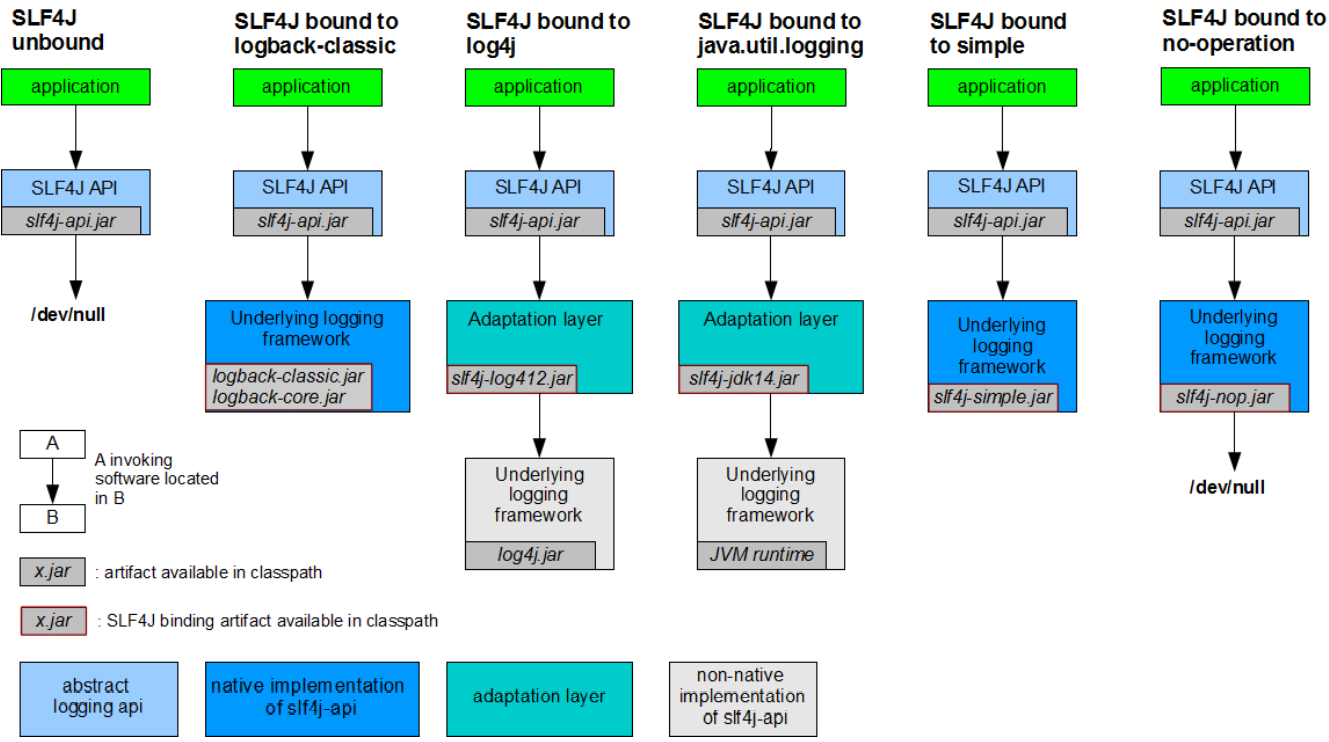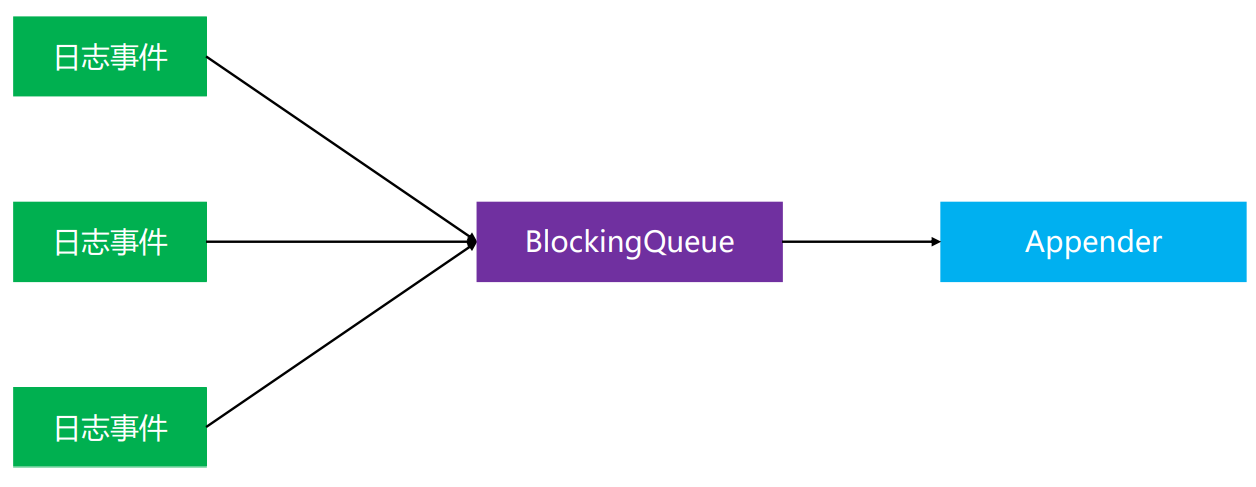Java from 0 to architect Directory: [Java from 0 to architect] learning record
Gitee Code: https://gitee.com/szluyu99/mj_java_frame/tree/master/04_SpringBoot
SLF4J supports various frameworks:

SLF4J + Log4j 1.x
Import dependency:
<!-- rely on slf4j-api,log4j 1.x -->
<dependency>
<groupId>org.slf4j</groupId>
<artifactId>slf4j-log4j12</artifactId>
<version>1.7.30</version>
</dependency>
Use example:
- In SLF4J, there is no FATAL level (or it can be understood that FATAL is equivalent to ERROR)
import org.slf4j.Logger;
import org.slf4j.LoggerFactory;
public class TestSLF4J_Log4j {
public static void main(String[] args) {
Logger logger = LoggerFactory.getLogger(TestSLF4J_Log4j.class);
log.error("error_ERROR");
log.warn("warning_WARN");
log.info("information_INFO");
log.debug("debugging_DEBUG");
log.trace("mark_TRACE");
}
}
Use Lombok to automatically generate the Logger definition of SLF4J:
@Slf4j
public class TestSLF4J_Log4j {
// Using @slf4j equivalent, the following code is generated
// private static final Logger logger =
// LoggerFactory.getLogger(TestSLF4J_Log4j.class);
public static void main(String[] args) {
log.error("error_ERROR");
log.warn("warning_WARN");
log.info("information_INFO");
log.debug("debugging_DEBUG");
log.trace("mark_TRACE");
}
}
SLF4J + Logback
Logback syntax is relatively free, and there is no constraint in its xml. Log4j 1 X has a dtd constraint
Import dependency:
<!-- rely on slf4j-api,logback-core -->
<dependency>
<groupId>ch.qos.logback</groupId>
<artifactId>logback-classic</artifactId>
<version>1.2.3</version>
</dependency>
Use example:
- Logback has a set of default configurations, which can be used without providing configuration files
log4j 1.x must provide a configuration file
@Slf4j
public class TestSLF4J_Logback {
// Using @slf4j equivalent, the following code is generated
// private static final Logger logger =
// LoggerFactory.getLogger(TestSLF4J_Logback.class);
public static void main(String[] args) {
for (int i = 0; i < 500; i++) {
log.error("error_ERROR");
log.warn("warning_WARN");
log.info("information_INFO");
log.debug("debugging_DEBUG");
log.trace("mark_TRACE");
}
}
}
Logback - Profile
Configuration file location: classpath: logback xml
Logback and log4j 1 The configuration content of X is very similar, which is easy to learn
<?xml version="1.0" encoding="UTF-8"?>
<configuration>
<!-- Extract public content -->
<property name="PATTERN"
value="%d{yyyy-MM-dd HH:mm:ss.SSS} [%-5p] [%t]: %m%n"/>
<property name="CHARSET" value="UTF-8"/>
<appender name="console" class="ch.qos.logback.core.ConsoleAppender">
<encoder class="ch.qos.logback.classic.encoder.PatternLayoutEncoder">
<charset>${CHARSET}</charset>
<pattern>${PATTERN}</pattern>
</encoder>
</appender>
<root level="INFO">
<appender-ref ref="console"/>
</root>
<logger name="com.mj" level="TRACE" additivity="false">
<appender-ref ref="console"/>
</logger>
</configuration>
Logback - console color printing
reference resources: Console color print document
<property name="PATTERN"
value="%d{HH:mm:ss.SSS} [%highlight(%-5p)] %cyan(%c{5}): %m%n"/>
<property name="CHARSET" value="UTF-8"/>
<appender name="console" class="ch.qos.logback.core.ConsoleAppender">
<encoder class="ch.qos.logback.classic.encoder.PatternLayoutEncoder">
<charset>${CHARSET}</charset>
<pattern>${PATTERN}</pattern>
</encoder>
</appender>
Logback - configuration
Common properties of the configuration tag:
- debug="true": you can print logs inside Logback
- scan="true" + scanPeriod="30 seconds"
Scan the profile every 30 seconds and apply the latest changes to the profile
The units of scanPeriod can be: milliseconds, seconds, minutes and hours
<?xml version="1.0" encoding="UTF-8"?> <configuration debug="true" scan="true" scanPeriod="5 seconds"> </configuration>
Logback - Appender controls the location of log output
Similar to Log4j, there are several Appender s in Logback:
- ConsoleAppender - output logs to the console
- FileAppender - output logs to a file (single)
- RollingFileAppender - output log to file (scroll)
FileAppender uses:
<appender name="file" class="ch.qos.logback.core.FileAppender">
<file>${BASE_PATH}/${BASE_NAME}.log</file>
<encoder class="ch.qos.logback.classic.encoder.PatternLayoutEncoder">
<charset>${CHARSET}</charset>
<pattern>${FILE_PATTERN}</pattern>
</encoder>
</appender>
<appender name="htmlFile" class="ch.qos.logback.core.FileAppender">
<file>${BASE_PATH}/${BASE_NAME}.html</file>
<encoder class="ch.qos.logback.core.encoder.LayoutWrappingEncoder">
<charset>${CHARSET}</charset>
<layout class="ch.qos.logback.classic.html.HTMLLayout">
<pattern>%d{yyyy-MM-dd HH:mm:ss.SSS}%p%t%m</pattern>
</layout>
</encoder>
</appender>
RollingFileAppender uses:
- Timebasedlollingpolicy: time based rollingpolicy
<appender name="rollingFile" class="ch.qos.logback.core.rolling.RollingFileAppender">
<file>${BASE_PATH}/${BASE_NAME}.log</file>
<encoder class="ch.qos.logback.classic.encoder.PatternLayoutEncoder">
<charset>${CHARSET}</charset>
<pattern>${PATTERN}</pattern>
</encoder>
<!-- Time based rolling strategy -->
<rollingPolicy class="ch.qos.logback.core.rolling.TimeBasedRollingPolicy">
<!-- Support compression -->
<fileNamePattern>${BASE_PATH}/logback_rolling_%d{yyy-MM-dd-HH-mm-ss}.log.gz</fileNamePattern>
<!-- Delete log files 20 seconds ago(The time unit depends on fileNamePattern) -->
<maxHistory>20</maxHistory>
<!-- Total log size limit(More than,Delete the oldest log) -->
<totalSizeCap>10KB</totalSizeCap>
</rollingPolicy>
</appender>
- Sizeandtimebasedlollingpolicy: scrolling based on file size and time
<!--Scrolling strategy based on file size and time -->
<rollingPolicy class="ch.qos.logback.core.rolling.SizeAndTimeBasedRollingPolicy">
<!-- Support compression -->
<fileNamePattern>${BASE_PATH}/logback_rolling_%d{HH-mm}_%i.log.gz</fileNamePattern>
<!-- Delete log files 20 seconds ago(The time unit depends on fileNamePattern) -->
<maxHistory>20</maxHistory>
<!-- When the log file size exceeds 1 MB,A new log file is generated -->
<maxFileSize>1MB</maxFileSize>
</rollingPolicy>
Logback - Filter filters log output information based on the Logger
Set Filter to print only WARN level information:
<appender name="console" class="ch.qos.logback.core.ConsoleAppender">
<encoder class="ch.qos.logback.classic.encoder.PatternLayoutEncoder">
<charset>${CHARSET}</charset>
<pattern>${CONSOLE_PATTERN}</pattern>
</encoder>
<!-- Print only WARN Level information -->
<filter class="ch.qos.logback.classic.filter.LevelFilter">
<level>WARN</level>
<!-- When matching: receive(Turn on Printing) -->
<onMatch>ACCEPT</onMatch>
<!-- When does not match: negative(Turn off printing) -->
<onMismatch>DENY</onMismatch>
</filter>
</appender>
You can also configure to turn off WARN and print only other levels:
<!-- close WARN,Open other -->
<filter class="ch.qos.logback.classic.filter.LevelFilter">
<level>WARN</level>
<onMatch>DENY</onMatch>
<onMismatch>ACCEPT</onMismatch>
</filter>
Logback - AsyncAppender makes logging asynchronous
In Logback, you can use AsyncAppender to improve efficiency
- The log writing operation will not affect the normal execution of the program (generally used for time-consuming operations such as writing logs to files)
<appender name="file" class="ch.qos.logback.core.FileAppender">
<file>${BASE_PATH}/${BASE_NAME}.log</file>
<encoder class="ch.qos.logback.classic.encoder.PatternLayoutEncoder">
<charset>${CHARSET}</charset>
<pattern>${PATTERN}</pattern>
</encoder>
</appender>
<appender name="async" class="ch.qos.logback.classic.AsyncAppender">
<!-- Capacity of blocking queue -->
<param name="queueSize" value="512"/>
<!-- When blocking the remaining 20 of the queue%Capacity time,It will be discarded by default TRACE,DEBUG,INFO Level log -->
<!-- discardingThreshold Set to 0,It won't be discarded -->
<param name="discardingThreshold" value="0"/>
<!-- take file this appender Set to asynchronous -->
<appender-ref ref="file"/>
</appender>
Principle of AsyncAppender:

Log4j 2.x
Example code: log4j 2.x
Import dependency:
<!-- rely on log4j-api -->
<dependency>
<groupId>org.apache.logging.log4j</groupId>
<artifactId>log4j-core</artifactId>
<version>2.13.3</version>
</dependency>
Basic usage: log4j 2 X the default log level is ERROR (without configuration file)
public class TestLog4j2 {
public static void main(String[] args) {
Logger logger = LogManager.getLogger(TestLog4j2.class);
logger.fatal("deadly_FATAL");
logger.error("error_ERROR");
logger.warn("warning_WARN");
logger.info("information_INFO");
logger.debug("debugging_DEBUG");
logger.trace("mark_TRACE");
}
}
Log4j 2.x - Profile
Configuration file: classpath: log4j2 xml
The configurations of various configuration files are similar. It's easy to understand with the previous foundation
<?xml version="1.0" encoding="UTF-8"?>
<Configuration>
<Properties>
<Property name="PATTERN">%d{HH:mm:ss.SSS} [%-5p] %c{1.}: %m %n</Property>
<Property name="CHARSET">UTF-8</Property>
</Properties>
<Appenders>
<Console name="Console">
<PatternLayout pattern="${PATTERN}" charset="${CHARSET}"/>
</Console>
</Appenders>
<Loggers>
<Root level="TRACE">
<AppenderRef ref="Console"/>
</Root>
<Logger name="com.mj" level="TRACE" additivity="false">
<AppenderRef ref="Console"/>
</Logger>
</Loggers>
</Configuration>
Common properties in the Configuration tab:
- Status: controls the printing level of Log4j internal logs, such as status="WARN"
- monitorInterval: how many seconds to scan the configuration file and apply the latest modification of the configuration file
<?xml version="1.0" encoding="UTF-8"?> <Configuration status="WARN" monitorInterval="5"> </Configuration>
Log4j 2.x - console color printing
reference resources: http://logging.apache.org/log4j/2.x/manual/layouts.html#Patterns
<Properties>
<Property name="PATTERN" value="%style{%d{HH:mm:ss.SSS}}{black}\
[%highlight{%t}] %highlight{%-5p}\
%style{%c{1.}}{magenta}: %m%n"/>
<Property name="CHARSET">UTF-8</Property>
</Properties>
<Appenders>
<Console name="Console" target="SYSTEM_OUT">
<!-- disableAnsi="false" Turn on color printing -->
<PatternLayout pattern="${PATTERN}" charset="${CHARSET}"
disableAnsi="false"/>
</Console>
</Appenders>
Log4j 2.x - Filter
Log4j 2. The commonly used filters in X are:
- ThresholdFilter - takes a certain level as the threshold to control whether to output logs
- LevelRangeFilter - controls the output of the log in a range
- LevelMatchFilter - matches a log level
- DenyAllFilter - disable all log levels
- StringMatchFilter - matches according to the string in the log information
ThresholdFilter uses:
<Console name="Console">
<PatternLayout pattern="${PATTERN}" charset="${CHARSET}"/>
<!-- achieve WARN -> DENY -> close -->
<!-- Not reached WARN -> ACCEPT -> open -->
<ThresholdFilter level="WARN" onMatch="DENY" onMismatch="ACCEPT"/>
</Console>
- ACCEPT: on; All subsequent filters will be ignored
- DENY: closed; All subsequent filters will be ignored
- NEUTRAL: NEUTRAL. Will be passed to
<!-- Open only[DEBUG,WARN]Level log --> <Filters> <ThresholdFilter level="ERROR" onMatch="DENY" onMismatch="NEUTRAL"> <ThresholdFilter level="DEBUG" onMatch="ACCEPT" onMismatch="DENY"> </Filters>
LevelRangeFilter uses:
- Note that in log4j 2 In the LevelRangeFilter of X,
minLevel is the maximum level and maxlLevel is the minimum level
<!-- Open only[DEBUG, WARN]Level log --> <Filters> <LevelRangeFilter minLevel="WARN" maxLevel="DEDBUG" onMatch="ACCEPT" onMismatch="DENY"/> </Filters>
Log4j 2.x - Appender
The structure of the log framework is similar, log4j 2 In X, you can specify the Appender directly through the label:
Log4j 1.x and Logback, specify the Appender through the < Appender > tag and class attribute
- < console >: output logs to the console
- < File >: output logs to a file (single)
- < rollingfile >: output log to file (scroll)
<Console>:
- target: the value can be SYSTEM_OUT (default), SYSTEM_ERR, controls the color of the output to the console
<Appenders>
<Console name="Console" target="SYSTEM_ERR">
<PatternLayout pattern="${PATTERN}" charset="${CHARSET}"/>
</Console>
</Appenders>
<File>:
<Properties>
<Property name="PATTERN">%d{HH:mm:ss.SSS} [%-5p] %c{1.}: %m %n</Property>
<Property name="CHARSET">UTF-8</Property>
<Property name="BASE_PATH">F:/logs</Property>
<Property name="BASE_NAME">log4j2</Property>
</Properties>
<File name="File" fileName="${BASE_PATH}/${BASE_NAME}_file.log">
<PatternLayout pattern="${PATTERN}" charset="${CHARSET}"/>
</File>
<RollingFile name="RollingFile"
fileName="${BASE_PATH}/${BASE_NAME}.log"
filePattern="${BASE_PATH}/%d{yyyy}/%d{MM}/%d{dd}/HH_mm_%i.log.gz">
<PatternLayout pattern="${PATTERN}" charset="${CHARSET}"/>
<Policies>
<!-- Time based scrolling strategy: scroll when the time span reaches 2 minutes -->
<!-- The time unit depends on filePattern Minimum time unit -->
<TimeBasedTriggeringPolicy interval="2"/>
<!-- File size based scrolling strategy: when the file size reaches 10 KB Scroll when -->
<SizeBasedTriggeringPolicy size="10KB"/>
</Policies>
<!-- The default value is 7,set up%i Maximum value of -->
</DefaultRolloverStrategy max="10">
</RollingFile>
Scroll policy - Delete
For output to a scrolling file, you can set a scrolling policy:
Reference documents: Delete
<!-- set up%i The default value is 7 -->
<DefaultRolloverStrategy max="100">
<!-- maxDepth: The maximum number of levels to access the directory, Default 1, Delegate access only basePath Files in directory -->
<Delete basePath="${BASE_PATH}" maxDepth="10">
<!-- IfFileName && IfLastModified -->
<!-- Fill in relative basePath Relative path of -->
<IfFileName glob="*.log.gz"/>
<!-- The file is older than 5 minutes s -->
<IfLastModified age="5s">
<!-- IfAccumulatedFileSize || IfAccumulatedFileCount -->
<IfAny>
<IfAccumulatedFileSize exceeds="20KB"/>
<IfAccumulatedFileCount exceeds="10"/>
</IfAny>
</IfLastModified>
</Delete>
</DefaultRolloverStrategy>
Log4j 2.x - Loggers
<Loggers>
<Root level="WARN">
<AppenderRef ref="Console"/>
</Root>
<Logger name="com.mj" level="TRACE" additivity="false">
<AppenderRef ref="RollingFile"/>
</Logger>
</Loggers>
Log4j 2.x - Async
<Console name="Console">
<PatternLayout pattern="${PATTERN}" charset="${CHARSET}"/>
</Console>
<Async name="Async">
<Appender-ref redf="Console"/>
</Async>
SLF4J + Log4j 2.x
Example code: SLF4J + Log4j 2.x
Import dependency:
<!-- rely on slf4j-api,log4j-api,log4j-core --> <dependency> <groupId>org.apache.logging.log4j</groupId> <artifactId>log4j-slf4j-impl</artifactId> <version>2.13.3</version> </dependency>
Code example:
import org.slf4j.Logger;
import org.slf4j.LoggerFactory;
public class TestSLF4J_Log4j2 {
public static void main(String[] args) {
Logger logger = LoggerFactory.getLogger(TestSLF4J_Log4j2.class);
log.error("error_ERROR");
log.warn("warning_WARN");
log.info("information_INFO");
log.debug("debugging_DEBUG");
log.trace("mark_TRACE");
}
}
Use @slf4j annotation:
import lombok.extern.slf4j.Slf4j;
@Slf4j
public class TestSLF4J_Log4j2 {
public static void main(String[] args) {
log.error("error_ERROR");
log.warn("warning_WARN");
log.info("information_INFO");
log.debug("debugging_DEBUG");
log.trace("mark_TRACE");
}
}